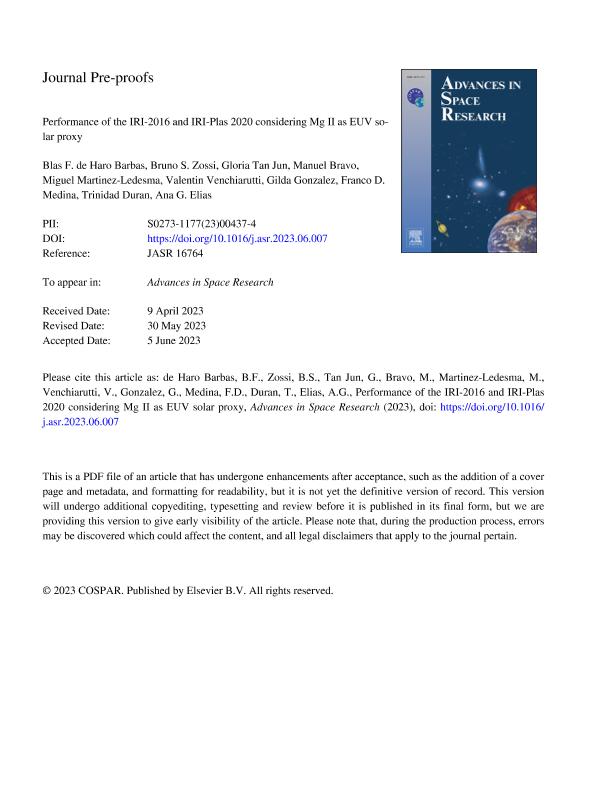Mostrar el registro sencillo del ítem
dc.contributor.author
de Haro Barbás, Blas Federico

dc.contributor.author
Zossi, Bruno Santiago

dc.contributor.author
Tan Jun Rios, María Gloria

dc.contributor.author
Bravo, Manuel
dc.contributor.author
Martínez Ledesma, Miguel

dc.contributor.author
Venchiarutti, José Valentín

dc.contributor.author
González, Gilda de Lourdes

dc.contributor.author
Medina, Franco Dario

dc.contributor.author
Duran, Trinidad

dc.contributor.author
Elias, Ana Georgina

dc.date.available
2024-02-05T09:47:10Z
dc.date.issued
2023-06
dc.identifier.citation
de Haro Barbás, Blas Federico; Zossi, Bruno Santiago; Tan Jun Rios, María Gloria; Bravo, Manuel; Martínez Ledesma, Miguel; et al.; Performance of the IRI-2016 and IRI-Plas 2020 considering Mg II as EUV solar proxy; Elsevier; Advances in Space Research; 72; 6; 6-2023; 2406-2417
dc.identifier.issn
0273-1177
dc.identifier.uri
http://hdl.handle.net/11336/225648
dc.description.abstract
To assess upper atmosphere parameters, current models use different variables to account for solar activity levels. Studies that evaluate the most recent solar cycles have shown that when dealing with the ionospheric F2 layer, and in particular with foF2, the Mg II index is a better choice than other solar activity proxies to account for solar EUV variation. The International Reference Ionosphere, version 2016 (IRI-2016), a model widely used by the scientific community, uses the Ionosonde Global (IG) index to assess foF2. A most recent and expanded version, IRI-Plas, allows selecting a solar activity proxy among 7 options including IG and Mg II. In the present work, the performance of IRI considering Mg II to assess foF2 is analyzed, comparing three modeling cases: IRI-2016 with its default solar activity index (IG), IRI-2016 with Mg II instead of IG, and IRI-Plas choosing Mg II as the solar proxy option. This model comparison was evaluated in terms of their agreement with measured foF2 data from four stations located in Japan (Northern Hemisphere), and four in Australia (Southern Hemisphere). Monthly medians for the 24 h, along two periods of three years were considered: 2000–2002 and 2008–2010, which correspond to epochs of maximum and minimum solar activity levels, respectively. Based on goodness-of-fit statistics, our results show that in the case of IRI-2016, the Mg II implementation does not reveal a significant improvement for foF2 assessment, and the IRI-Plas performance with the Mg II option is only slightly better than the other two options. Dispersion diagrams between measured and modeled foF2 also evince a similar performance between the three models. All models show the same over- and underestimation patterns, except in the nighttime case during the minimum activity level period for both Australian and Japanese stations where IRI-Plas outperforms the other two model options. The comparable performances of the three options might be attributed to a stronger variation in the evaluated periods which could be related to seasonal changes rather than to solar EUV proxies. Future studies considering time series over several years, covering at least a complete solar activity cycle, are required to determine stronger model performance differences.
dc.format
application/pdf
dc.language.iso
eng
dc.publisher
Elsevier

dc.rights
info:eu-repo/semantics/openAccess
dc.rights.uri
https://creativecommons.org/licenses/by-nc-sa/2.5/ar/
dc.subject
COMPARATIVE ANALYSIS
dc.subject
FOF2
dc.subject
INTERNATIONAL REFERENCE IONOSPHERE
dc.subject
MG II INDEX
dc.subject
SOLAR ACTIVITY PROXIES
dc.subject.classification
Otras Ciencias de la Tierra y relacionadas con el Medio Ambiente

dc.subject.classification
Ciencias de la Tierra y relacionadas con el Medio Ambiente

dc.subject.classification
CIENCIAS NATURALES Y EXACTAS

dc.title
Performance of the IRI-2016 and IRI-Plas 2020 considering Mg II as EUV solar proxy
dc.type
info:eu-repo/semantics/article
dc.type
info:ar-repo/semantics/artículo
dc.type
info:eu-repo/semantics/publishedVersion
dc.date.updated
2024-01-16T14:11:15Z
dc.journal.volume
72
dc.journal.number
6
dc.journal.pagination
2406-2417
dc.journal.pais
Países Bajos

dc.journal.ciudad
Amsterdam
dc.description.fil
Fil: de Haro Barbás, Blas Federico. Universidad Nacional de Tucumán; Argentina
dc.description.fil
Fil: Zossi, Bruno Santiago. Universidad Nacional de Tucumán. Instituto de Física del Noroeste Argentino. - Consejo Nacional de Investigaciones Científicas y Técnicas. Centro Científico Tecnológico Conicet Noa Sur. Instituto de Física del Noroeste Argentino; Argentina
dc.description.fil
Fil: Tan Jun Rios, María Gloria. No especifíca;
dc.description.fil
Fil: Bravo, Manuel. Universidad Adventista de Chile (unach);
dc.description.fil
Fil: Martínez Ledesma, Miguel. Universidad de Concepción; Chile
dc.description.fil
Fil: Venchiarutti, José Valentín. Universidad Nacional de Tucumán; Argentina. Consejo Nacional de Investigaciones Científicas y Técnicas; Argentina
dc.description.fil
Fil: González, Gilda de Lourdes. Universidad Nacional de Tucumán. Instituto de Física del Noroeste Argentino. - Consejo Nacional de Investigaciones Científicas y Técnicas. Centro Científico Tecnológico Conicet Noa Sur. Instituto de Física del Noroeste Argentino; Argentina
dc.description.fil
Fil: Medina, Franco Dario. Universidad Nacional de Tucumán. Instituto de Física del Noroeste Argentino. - Consejo Nacional de Investigaciones Científicas y Técnicas. Centro Científico Tecnológico Conicet Noa Sur. Instituto de Física del Noroeste Argentino; Argentina
dc.description.fil
Fil: Duran, Trinidad. Consejo Nacional de Investigaciones Científicas y Técnicas. Centro Científico Tecnológico Conicet - Bahía Blanca. Instituto de Física del Sur. Universidad Nacional del Sur. Departamento de Física. Instituto de Física del Sur; Argentina
dc.description.fil
Fil: Elias, Ana Georgina. Universidad Nacional de Tucumán. Instituto de Física del Noroeste Argentino. - Consejo Nacional de Investigaciones Científicas y Técnicas. Centro Científico Tecnológico Conicet Noa Sur. Instituto de Física del Noroeste Argentino; Argentina
dc.journal.title
Advances in Space Research

dc.relation.alternativeid
info:eu-repo/semantics/altIdentifier/url/https://linkinghub.elsevier.com/retrieve/pii/S0273117723004374
dc.relation.alternativeid
info:eu-repo/semantics/altIdentifier/doi/http://dx.doi.org/10.1016/j.asr.2023.06.007
Archivos asociados
